The Intel Core i5-7600K (91W) Review: The More Amenable Mainstream Performer
by Ian Cutress on January 3, 2017 12:01 PM ESTOffice Performance
The dynamics of CPU Turbo modes, both Intel and AMD, can cause concern during environments with a variable threaded workload. There is also an added issue of the motherboard remaining consistent, depending on how the motherboard manufacturer wants to add in their own boosting technologies over the ones that Intel would prefer they used. In order to remain consistent, we implement an OS-level unique high performance mode on all the CPUs we test which should override any motherboard manufacturer performance mode.
All of our benchmark results can also be found in our benchmark engine, Bench.
Dolphin Benchmark: link
Many emulators are often bound by single thread CPU performance, and general reports tended to suggest that Haswell provided a significant boost to emulator performance. This benchmark runs a Wii program that raytraces a complex 3D scene inside the Dolphin Wii emulator. Performance on this benchmark is a good proxy of the speed of Dolphin CPU emulation, which is an intensive single core task using most aspects of a CPU. Results are given in minutes, where the Wii itself scores 17.53 minutes.

Since a big uptick in emulator performance with Sandy Bridge, the Intel processor line has had a good run in Dolphin and that continues with Kaby Lake. This is shown with the Core i7-7600K coming above the i7-6700K and i7-4790K, both former leaders in this benchmark.
WinRAR 5.0.1: link
Our WinRAR test from 2013 is updated to the latest version of WinRAR at the start of 2014. We compress a set of 2867 files across 320 folders totaling 1.52 GB in size – 95% of these files are small typical website files, and the rest (90% of the size) are small 30 second 720p videos.
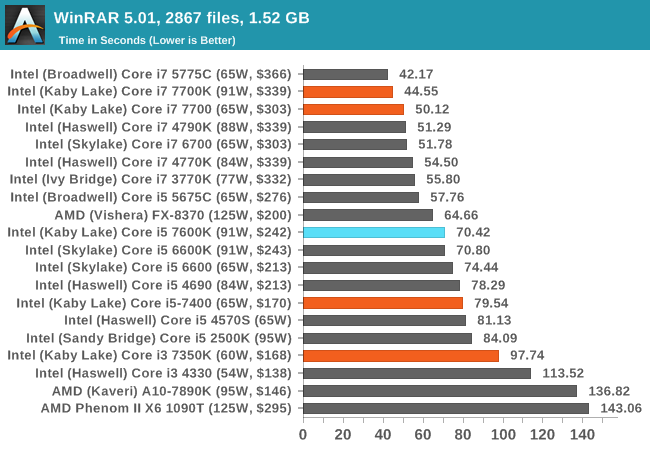
WinRAR is more geared towards a variable threaded environment but also memory speed. In the last of ‘which benchmarks benefit from hyperthreads’, WinRAR is in – almost every Core i5 takes a back seat to all the Core i7 parts. We see performance jumps moving from i3 to i5, and a smaller one from i5 to i7, but in the case of WinRAR it’s quite obvious that threads matter here.
3D Particle Movement v2
3DPM is a self-penned benchmark, taking basic 3D movement algorithms used in Brownian Motion simulations and testing them for speed. High floating point performance, MHz and IPC wins the day. This is the second variant of this benchmark, fixing for false sharing in the first version, and lending itself to better multithreaded performance.
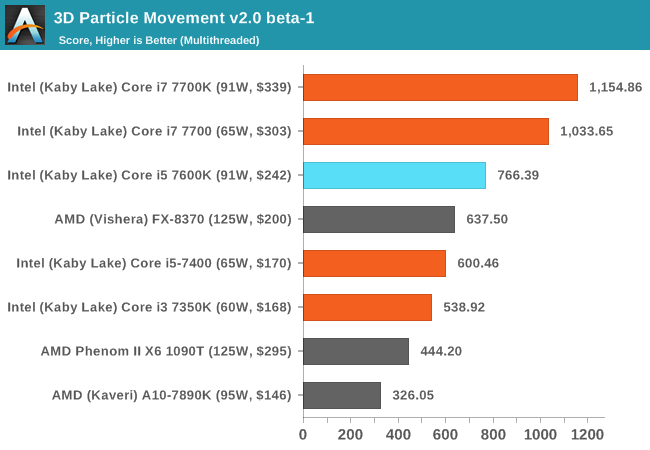
3DPMv2 is still new, so we don’t have too many results for it so far – even to go and say that Kaby Lake is the only set of i5 processors it has been run on. 3DPMv2, like WinRAR, likes hyperthreads as well, so we see the Core i7-6700T sit above the i5-7600K despite the frequency difference. In a benchmark like this, the older AMD FX processors come into play and the FX-8370 knocks on the door of the i5.
SYSMark 2014
Engineered by BAPco (to which Intel is a consortium member), this set of tests are designed to be an office/data/media/financial range of tests using common well-known CAD, image editing, web browsing and other tools to put out a score, where a score of 1000 is attributed to an old Core i3 using a mechanical harddrive. Here we report the overall score, however the test breakdowns can be found in Bench.
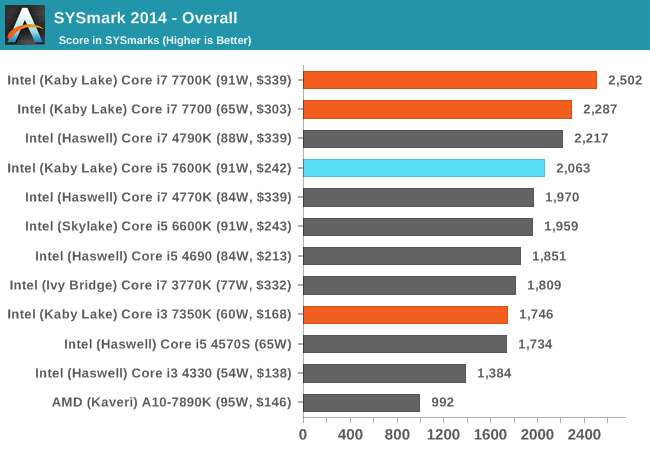
Because SYSMark is a variety of tests that rely on response and throughput, the Core i5-7600K hits a good score in the middle of most of the previous generation extreme processors but also gives a good 5% on the previous generation i5-6600K.
Web Benchmarks
On the lower end processors, general usability is a big factor of experience, especially as we move into the HTML5 era of web browsing. For our web benchmarks, we take well known tests with Chrome as installed by SYSMark as a consistent browser.
Mozilla Kraken 1.1
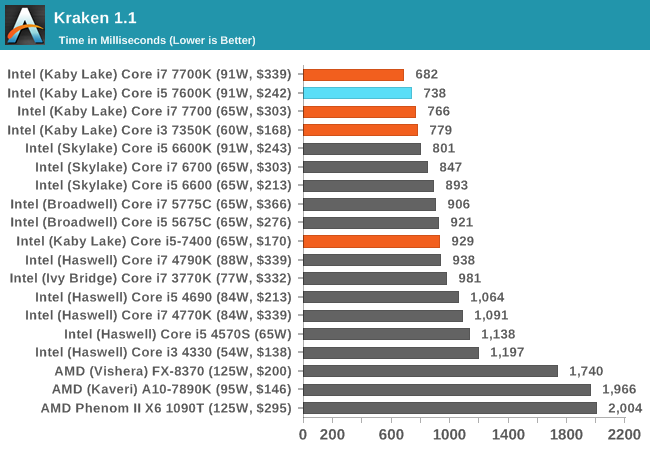
Google Octane v2
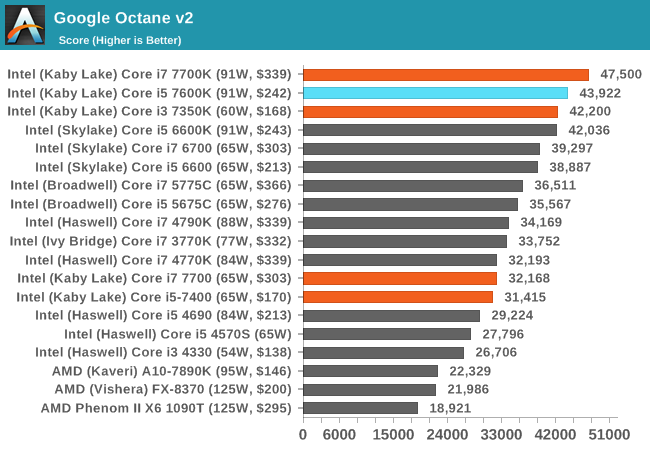










70 Comments
View All Comments
Gastec - Wednesday, January 11, 2017 - link
I remember that when Windows XP came out, more than 15 years ago, eveybody was crying out loud (some hysterically) that Windows 98 is waaay better and they will never upgrade to XP.But enough about operating systems, that discussion is irrelevant. I'm more interested in learning about the things (voices?) that YOU HEAR and record :)
serpretetsky - Tuesday, January 3, 2017 - link
Maybe I went over the article too fast, is there something specific about this chip to windows 10?nico_mach - Tuesday, January 3, 2017 - link
Speedstep is unique to Windows 10.Bullwinkle J Moose - Tuesday, January 3, 2017 - link
probably not but do any of the motherboards support IDE ?Does the chip itself have XP drivers?
Probably not
Waste of money
Murloc - Tuesday, January 3, 2017 - link
if you don't like windows you can use linux.With XP you're not getting the most recent versions of directx anyway so you're probably not gaming on it, so what's the reason for sticking to windows?
doggface - Wednesday, January 4, 2017 - link
Seriously... Wow. Troll much.Bullwinkle J Moose - Wednesday, January 4, 2017 - link
neverShadow7037932 - Wednesday, January 4, 2017 - link
Loss of $500-1K from you is not a big deal for Intel or any other OEM.Outlander_04 - Tuesday, January 3, 2017 - link
Looks like intel are worried about Zen enough they have bumped up stock clocks .They have achieved that with out too much extra power consumption which is something I guess , but kaby lake is not a step forward
Murloc - Tuesday, January 3, 2017 - link
optimization is just that, why would we expect something more?